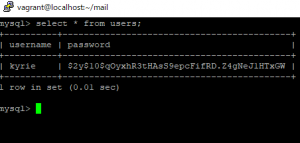セッションに値がある場合は、コンテンツを表示させ、それ以外は、ログインページにリダイレクトさせる。
session_start();
if(isset($_SESSION["username"])){
echo "ログイン中です。";
} else {
header('Location: login.php');
}
ふむふむ

session destroy もしくは nullの場合はログインページにリダイレクト

ログイン・サインインの基本機能はできたかな?
随机应变 ABCD: Always Be Coding and … : хороший
セッションに値がある場合は、コンテンツを表示させ、それ以外は、ログインページにリダイレクトさせる。
session_start();
if(isset($_SESSION["username"])){
echo "ログイン中です。";
} else {
header('Location: login.php');
}
ふむふむ

session destroy もしくは nullの場合はログインページにリダイレクト

ログイン・サインインの基本機能はできたかな?
id 英数字3~32文字、パスワード英数字8~32文字のバリデーション
<?php
require_once("auth.php");
$mysqli = connect_mysql();
$status = "none";
if(!empty($_POST["username"]) && !empty($_POST["password"])){
if(!preg_match('/^[0-9a-zA-Z]{3,32}$/', $_POST["username"]))
$status = "error_username";
//パスワードのチェック
else if(!preg_match('/^[0-9a-zA-Z]{8,32}$/', $_POST["password"]))
$status = "error_password";
else{
$password = password_hash($_POST["password"], PASSWORD_DEFAULT);
$stmt = $mysqli->prepare("INSERT INTO users VALUES (?, ?)");
$stmt->bind_param('ss', $_POST["username"], $password);
if($stmt->execute())
$status = "ok";
else
$status = "failed";
}
}
?>
<head>
<script src="http://code.jquery.com/jquery-2.0.0.min.js"></script>
<script src="register_check.js"></script>
</head>
<h1>Jmail新規登録</h1>
<?php if($status == "ok"):?>
<p>登録完了</p>
<?php elseif($status == "failed"): ?>
<p>エラー:既に存在するユーザ名です。</p>
<?php elseif($status == "none"): ?>
<p>ユーザ名(英数字3~32文字)、推測されにくいパスワード(英数字8~32文字)を入力してください。</p>
<form method="POST" action="">
ユーザ名:<input type="text" name="username">
パスワード:<input type="password" name="password">
<input type="submit" value="登録">
</form>
<?php else: ?>
<p>hogehoge</p>
<?php endif; ?>
register_check.js
$(function(){
$("form").submit(function(){
if(!$("input[name=username]").val().match(/^[0-9a-zA-Z]{3,32}$/)
|| !$("input[name=password]").val().match(/^[0-9a-zA-Z]{8,32}$/)){
alert("入力エラー");
return false;
}
return true;
});
});

<?php session_start(); $_SESSION = array(); session_destroy(); ?> <h1>ログアウト</h1> <p>完了<p>

ログイン機能をつくっていた際に、何故かpassword_verifyが上手くいかなかったが、

create tableする際に、passwordの桁数が少なかったのが原因。
passwordを255にして
create table mail.users( username varchar(41) unique, password varchar(255) )
再度password_hashしたら、上手く機能しました。
<?php
session_start();
$mysqli = new mysqli('localhost', 'hoge', 'hogehoge', 'mail');
$status = "none";
if(isset($_SESSION["username"]))
$status = "logged_in";
else if(!empty($_POST["username"]) && !empty($_POST["password"])){
$stmt = $mysqli->prepare("SELECT password FROM users WHERE username = ?");
$stmt->bind_param('s', $_POST["username"]);
$stmt->execute();
$stmt->store_result();
if($stmt->num_rows == 1){
$stmt->bind_result($pass);
while ($stmt->fetch()) {
if(password_verify($_POST["password"], $pass)){
$status = "ok";
$_SESSION["username"] = $_POST["username"];
break;
}else{
$status = "failed";
break;
}
}
}else
$status = "failed";
}
?>
<h1>ログイン</h1>
<?php if($status == "logged_in"): ?>
<p>ログイン済み</p>
<?php elseif($status == "ok"): ?>
<p>ログイン成功</p>
<?php elseif($status == "failed"): ?>
<p>ログイン失敗</p>
<?php else: ?>
<form method="POST" action="login.php">
ユーザ名:<input type="text" name="username" />
パスワード:<input type="password" name="password" />
<input type="submit" value="ログイン" />
</form>
<?php endif; ?>
db table
create table mail.users( username varchar(41) unique, password varchar(41) )
register.php
<?php
$mysqli = new mysqli('localhost', 'hoge', 'hogehoge', 'mail');
$status = "none";
if(!empty($_POST["username"]) && !empty($_POST["password"])){
$password = password_hash($_POST["password"], PASSWORD_DEFAULT);
$stmt = $mysqli->prepare("INSERT INTO users VALUES (?, ?)");
$stmt->bind_param('ss', $_POST["username"], $password);
if($stmt->execute())
$status = "ok";
else
$status = "failed";
}
?>
<h1>新規登録</h1>
<?php if($status == "ok"):?>
<p>登録完了</p>
<?php elseif($status == "failed"): ?>
<p>エラー:既に存在するユーザ名です。</p>
<?php else: ?>
<form method="POST" action="">
ユーザ名:<input type="text" name="username">
パスワード:<input type="password" name="password">
<input type="submit" value="登録">
</form>
<?php endif; ?>

db

なるほど。
まずは簡易的な設計にしたいので、
Mysql側のテーブルは、(1)account、(2)send、(3)receive の3つぐらいでしょうか。
sendのテーブルとtoで指定したaddressのreceiveテーブルに、メール文を保存して、
送信者・受信者がお互いに見れるようにする。受信者は、メールを見たら、alreadyreadのフラグを立てる。
create table mail.account(
id int unsigned auto_increment primary key,
address varchar(255),
passwords varchar(255),
name varchar(255)
);
create table mail.send( id int unsigned auto_increment primary key, accountid varchar(255), to varchar(255), subject varchar(255), body varchar(255), file1 varchar(255), file2 varchar(255), alreadyread int, sendtime datetime default null );
create table mail.receive( id int unsigned auto_increment primary key, accountid varchar(255), subject varchar(255), body varchar(255), file1 varchar(255), file2 varchar(255), to varchar(255), from varchar(255), alreadyread int, junk int, delete int, receivetime datetime default null );
ああああ、singin・loginフォーム作らないと駄目だ。。
投信の会社などは、メールフォームがないのがトレンドのようですが、
さて、mb_send_mailを使います。vagrant postfixで設定している為、fromの挙動が異なります。
form.php
<title>Form</title> <body> <form action="send.php" method="post"> 件名:<br> <input type="text" name="subject" size="30" value=""/><br> 送信者名:<br> <input type="text" name="name" size="30" value=""/><br> メールアドレス:<br> <input type="text" name="mail" size="30" value=""/><br> 本文:<br> <textarea name="message" cols="30" rows="5"></textarea><br> <br> <input type="submit" value="送信する"/> </form> </body>

send.php
<?php
$message = "名前:" .htmlspecialchars($_POST["name"])."\n本文:".htmlspecialchars($_POST["message"]);
if(!mb_send_mail("hoge@gmail.com", $_POST["subject"], $message, "From:".$_POST["mail"])){
exit("error");
}
?>
<p>メールが送信されました</p>

Postfixのdependency(remi)を解消してsudo yum install php-imap後、php.iniでextension=imap.soを追加しても、
全くphpinfo()に反映されず、vagrant haltしたり、php.iniを編集したり、
他のサイトを見ながら5時間くらい色々試しても全然ダメで、
あきらめてカタ焼きそば食って再度vagrant upしてみたら、入っている!? 何故だ? さっぱりわからん。

とりあえずエラーは出ない模様
$imapPath = '{imap.gmail.com:993/imap/ssl/novalidate-cert}INBOX';
$username = 'hoge@gmail.com';
$password = 'pass';
// try to connect
$inbox = imap_open($imapPath,$username,$password) or die('Cannot connect to Gmail:'.imap_last_error());
$mailHost = 'imap.googlemail.com';
$mailPort = 993;
$mailAccount = 'hoge@gmail.com';
$mailPassword = '';
$mailBox = imap_open('{' . $mailHost . ':' . $mailPort . '/novalidate-cert/imap/ssl}' . "INBOX", $mailAccount, $mailPassword);
if (!$mailBox) {
echo '接続失敗';
}
echo '接続成功';
あれあれあれ

サーバーにグローバルなドメインが設定されていない場合、送受信できないとのこと。理由として、mail.hoge.localのドメインがLAN内のみ有効で世界のインターネット上では名前解決出来ない為。
個人情報に関わるからでしょうか、かなり厳しいですね。。
vimで /query で探した場合に、
押下”n”で次を検索
